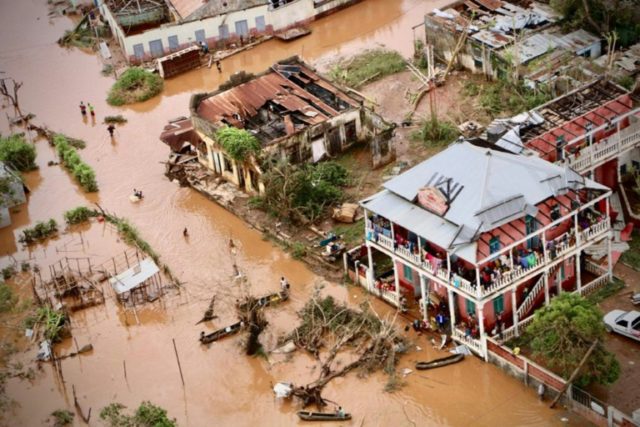Beira (Mozambique) (AFP) – A cyclone that ravaged three southern African countries last week has killed at least 350 people, affected more than 1.7 million others and left 15,000 people still stranded by floods, according to estimates Thursday.
As the toll surged from the region’s biggest storm in years, the World Health Organization (WHO) announced plans to tackle an emerging threat to survivors from malaria and cholera.
Cyclone Idai smashed into the coast of central Mozambique last Friday, unleashing hurricane-force winds and rains that flooded the hinterland and drenched eastern Zimbabwe.
Mozambican Land and Environmental Minister Celso Correia said 217 lives had been lost and 15,000 out of 18,000 stranded people still needed to be saved.
“Yesterday we had counted 15,000 people that still need rescue today — 15,000 people who are in bad shape. They are alive, we are communicating with them, delivering food, but we need to rescue them and take them out,” he told reporters.
A total of 65,000 people are in transit centres, he said.
“Our priority now is to make sure we take food, shelter and medicine to the people that are isolated in small islands or in big islands and villages,” Correia said at Beira airport, the humanitarian relief coordination hub.
World Food Programme (WFP) spokesman Herve Verhoosel said the number of people affected in Mozambique was 600,000, but warned: “That number will definitely go up.”
Ultimately, around 1.7 million people in Mozambique will need assistance, Verhoosel said in Geneva.
In Zimbabwe, state broadcaster ZBC said the death toll had risen to 139, up from 100 on Wednesday, while the WFP said its estimates of the number of people there affected by the cyclone had jumped from 15,000 to 200,000.
In Chimanimani, close to Zimbabwe’s border with Mozambique, “some 90 percent of the district has been significantly damaged,” Verhoosel said.
– Like a war zone –
An AFP reporter in the area said the district had been cut off.
Roads had been gobbled up by massive sinkholes and bridges ripped to shreds by flash floods — a landscape that Zimbabwe’s acting defence minister Perrance Shiri, who is also agriculture minister, said “resembles the aftermath of a full-scale war”.
Families on Wednesday were using hoes to dig through mounds of soil in search of their missing relatives, the reporter saw.
In Malawi, the WHO said on Wednesday, the storm had affected 922,000 others, of whom 82,000 had been displaced.
The WHO announced an emergency plan for 10,000 people.
“The displacement of large numbers of people and the flooding triggered by Cyclone Idai significantly increases the risk of malaria, typhoid and cholera,” said Matshidiso Moeti, the agency’s regional director for Africa.
The three countries are some of the poorest in the region and depend heavily on foreign aid.
– Call for help –
The UN launched an appeal for assistance overnight.
“We do not yet know enough about the level of destruction to give an accurate estimate of the amount of this call for funds, but it will be important,” spokesman Farhan Haq said at UN headquarters in New York.
Aid agencies said they were prepared for the cyclone which made landfall early Friday, but not for the massive floods that followed.
Mozambique bore the brunt from rivers that flow downstream from its neighbours.
Air force personnel from Mozambique and South Africa have been drafted in to fly rescue missions and distribute aid in central Mozambique.
Roads out of Beira have been destroyed and the city itself, home to around half a million people, has been 90-percent damaged or destroyed.

COMMENTS
Please let us know if you're having issues with commenting.